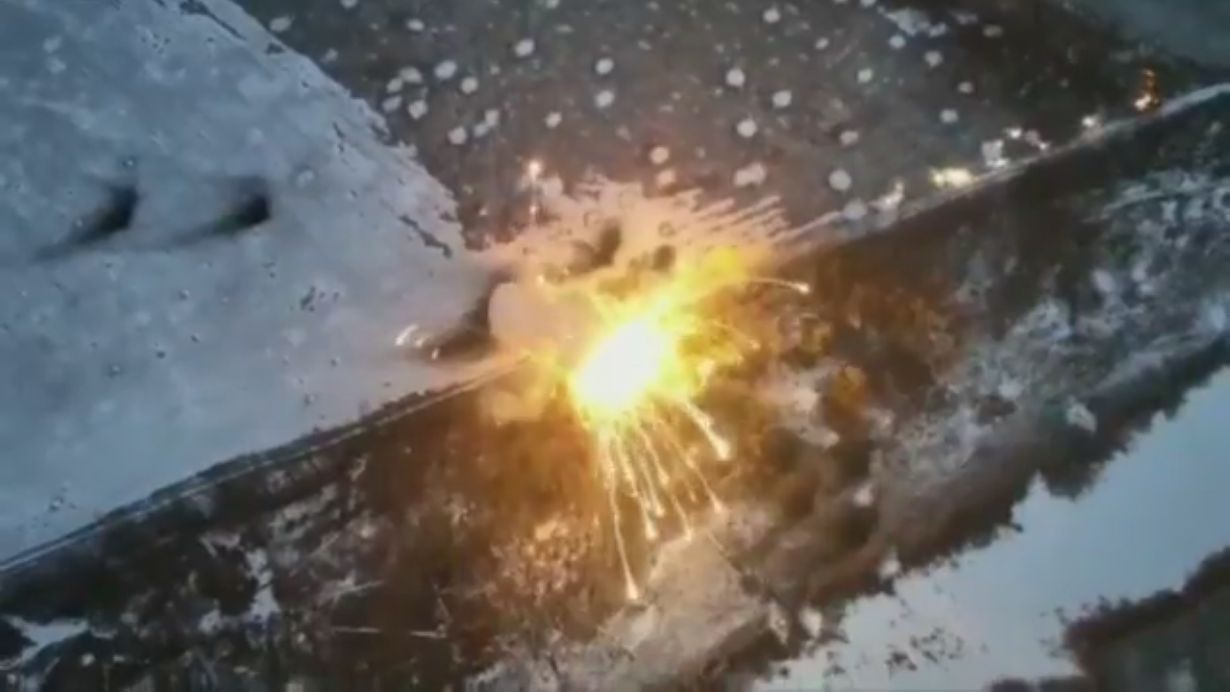On February 15, Ukrainian security forces released a video showing the obliteration of a Russian thermobaric rocket launcher after being struck in eastern Ukraine.
The footage shows the Russian thermobaric rocket launcher destroyed by a succession of fireball explosions. The head of the Ukrainian presidential administration, Andriy Yermak, uploaded the video on Telegram.
The video’s description read, “The 72 Brigade… have fried a Russian ‘SoIntsepiok.’ The launcher that was destroyed was a TOS-1 or TOS-1A, a multiple rocket system with the ability to fire thermobaric weapons.
The launcher was said to be in the Donetsk region of eastern Ukraine, south of Kharkiv, claimed Ukrainian authorities. This weapon system is documented to have been employed by Russian forces since the early stages of Moscow’s invasion of Ukraine.
The Ukrainian ambassador to the United States, Oksana Markarova, stated within days of the attack that thermobaric weapons, also known as “vacuum bombs,” were used in Ukraine.
The Ukrainian 72nd Brigade claimed to destroy a Russian TOS-1A thermobaric multiple rocket launcher in the vicinity of Vuhledar, #Donetsk Oblast. pic.twitter.com/YdtSIjhdUX
— Revolution Radio ⚪ (@Freedom_Slips) February 15, 2023
In Early February 2023, the Critical Threats project reported that Russian forces have been employing the TOS-1A thermobaric artillery system on the front lines of the Donetsk conflict.
Russia’s TOS-1 or TOS-1A multiple rocket launchers can carry thermobaric warheads. Conventional ammo is not used with these kinds of weapons. They are stuffed with high-pressure explosives.
They are frequently called “vacuum bombs” because they draw oxygen from the surrounding air to produce an intense explosion and a massive pressure wave that can wreak a great deal of destruction.
Such weapon systems’ usage near the contested town of Vuhledar demonstrated Russian forces’ relative prioritization for this region. Late in 2022, video of multiple TOS-1 rocket launchers being used near Bakhmut, a Donetsk city, also surfaced.

Russian TOS-1 Or TOS-1A In Ukraine
The TOS-1 and TOS-1A 220mm artillery systems are fitted on the main battle tank chassis and can launch 24 to 30 thermobaric rockets.
The TOS-1A is developed to suppress a wide range of covered and open targets with thermobaric rockets, according to the website of the Russian state defense organization Rosoboronexport.
According to an assessment by the British military ministry on March 9, 2022, the TOS-1A uses thermobaric rockets to produce incendiary explosion effects.
It can be combat-ready in 90 seconds and has a maximum firing range of 6000 meters, according to Rosoboronexport, which describes it as an “extremely lethal weapon” with tremendous combat potential. The maximum range, according to Russian state media, is 5.6 miles.
The Russian military designates the TOS-1 and TOS-1A as flamethrowers, and their purpose is to lob a heavy explosive over a short range.
In November 2022, Russia’s Omsk transport machine factory announced that it had delivered a new batch of TOS-1A Solntsepyok to the frontline. It was not stated how many of them were delivered.

Furthermore, it is unknown if those vehicles were new or whether they had been upgraded with new components. Since the beginning of the Russian invasion, this weaponry has been deployed in Ukraine by different military regions of the Russian Federation.
The weapon system has been particularly effective against troops who have dug in. Given that Russia only has a “small number” of these launchers, it would be more unlikely to see them utilized against tanks or infantry in open terrain.
Despite extensive advertising by the Russian military-industrial complex and repeated assertions in Russian media about the high efficacy of TOS-1 and TOS-1A Heavy Flamethrower Systems, Ukrainian forces frequently released footage showing the vulnerability of these systems in modern battlefields.
Previously, Ukrainian forces claimed that a video released by Russia illustrated the disadvantages of a Heavy Flamethrower System in actual hostilities.
The video showed the TOS-1A Solntsepyok in action and firing toward the Ukrainian village of Dovhenke in the Kharkiv region.
Ukrainian media noted that the TOS-1A missed eight consecutive shots despite adjusting the fire with the help of a Russian drone through which the crew obtained coordinates.
Its firing range is another source of concern for its operator. The TOS-1A is said to have an effective range of about 6,000 meters. For the circumstances of a modern conflict, this is insufficient. Thus, the crew of the weapon system is forced to enter areas where Ukrainian artillery weapons are deployed.
- Contact the author at ashishmichel(at)gmail.com
- Follow EurAsian Times on Google News




